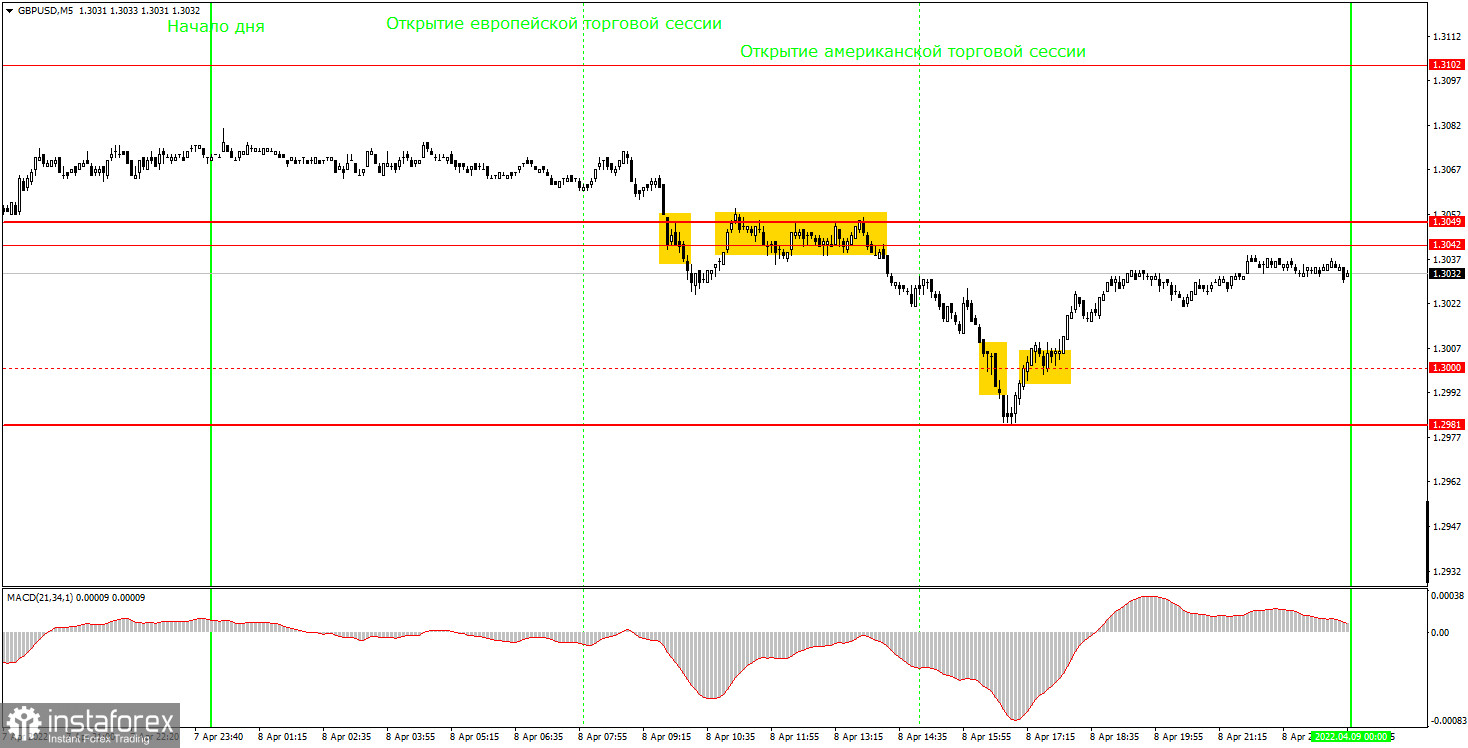Analyzing trades on Friday:
GBP/USD 30M chart

Trading activity on GBP/USD on Friday was much higher than that on EUR/USD. During the day, the British currency managed to show a decline and a subsequent correction. The general volatility was within 100 pips, which is quite a lot given that the economic calendar was almost empty that day. That is why it was surprising to see a new decline in the pound. We have repeatedly mentioned for several weeks that the fundamental background continues to be a strong factor supporting the US dollar. Therefore, GPB is likely to continue its fall. It would be logical if the decline in quotes happened after disappointing news. However, this was not the case. What is more important now is that neither a channel nor a trendline has been formed on the pound/dollar chart, which makes the movement mixed. This is neither a trend nor a flat. The pair has been trading above 1.3049 and below 1.3180 for nine days within the sideways channel but with a slight downside slope at the same time. In general, the situation is ambiguous. Only one thing is certain - the pound is depreciating and will probably continue to fall.
GBP/USD 5M chart

On the 5-minute time frame, the movement of the pair on Friday was reasonable. In the European trading session, two sell signals were formed near the area of 1.3042-1.3049. First, the price broke through this area from top to bottom and then bounced off it, even though it took it several hours to do this. At this point, traders should have opened a short trade. Right after the formation of these signals, the pair went down by no less than 50 pips. On its way down, the pair also passed the level of 1.3000 but failed to go much lower beyond it. In a few hours, the quote returned above this level. At this point, it was possible to close your sell positions manually with a profit of about 25 pips. Traders could have also opened a buy position when the price settled above 1.3000. In this case, the trade had to be closed manually since the price failed to reach the target level. Regardless of the closing level, the trade could have brought a small profit. In fact, two trades were opened and both of them turned out to be profitable.
Trading tips on Monday:
Formally, there is a downtrend on the 30-minute time frame. The problem is that neither a trendline nor a channel can be formed at the moment. Therefore, the current trend movement looks uncertain. The pair either trades in a flat channel or moves with a minimal downward bias. Therefore, it is possible to say that the pound will continue to fall, but it is very difficult to predict the pace and the nature of the movement on a 30-minute time frame. On the 5-minute chart on Monday, it is recommended to trade at the levels of 1.2981, 1.3042-1.3049, 1.3102, and 1.3156. When the price passes 20 pips in the right direction, you should set a Stop Loss to breakeven. A bunch of macroeconomic data is scheduled for Monday in the UK, including reports on GDP, industrial production, and trade balance. Naturally, special attention should be paid to the GDP data. Meanwhile, nothing is expected in the US on Monday.
Basic rules of the trading system
1) The strength of the signal is determined by the time it took the signal to form (a rebound or a breakout of the level). The quicker it is formed, the stronger the signal is.
2) If two or more positions were opened near a certain level based on a false signal (which did not trigger a Take Profit or test the nearest target level), then all subsequent signals at this level should be ignored.
3) When trading flat, a pair can form multiple false signals or not form them at all. In any case, it is better to stop trading at the first sign of a flat movement.
4) Trades should be opened in the period between the start of the European session and the middle of the US trading hours, when all positions must be closed manually.
5) You can trade using signals from the MACD indicator on the 30-minute time frame only amid strong volatility and a clear trend that should be confirmed by a trendline or a trend channel.
6) If two levels are located too close to each other (from 5 to 15 pips), they should be considered support and resistance levels.
On the chart
Support and Resistance Levels are the levels that serve as targets when buying or selling the pair. You can place Take Profit near these levels.
Red lines are channels or trend lines that display the current trend and show in which direction it is better to trade now.
The MACD indicator (14, 22, and 3) consists of a histogram and a signal line. When they cross, this is a signal to enter the market. It is recommended to use this indicator in combination with trend patterns (channels and trendlines).
Important announcements and economic reports that can be found on the economic calendar can seriously influence the trajectory of a currency pair. Therefore, at the time of their release, we recommend trading as carefully as possible or exiting the market in order to avoid sharp price fluctuations.
Beginners on Forex should remember that not every single trade has to be profitable. The development of a clear strategy and money management is the key to success in trading over a long period of time.
 English
English 
 Русский
Русский Bahasa Indonesia
Bahasa Indonesia Bahasa Malay
Bahasa Malay ไทย
ไทย Español
Español Deutsch
Deutsch Български
Български Français
Français Tiếng Việt
Tiếng Việt 中文
中文 বাংলা
বাংলা हिन्दी
हिन्दी Čeština
Čeština Українська
Українська Română
Română

